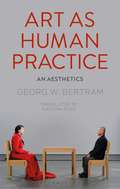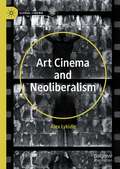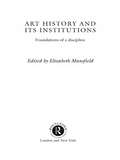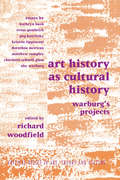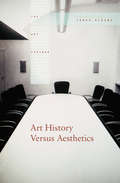- Table View
- List View
Art as Human Practice: An Aesthetics
by Georg W. BertramHow is art both distinct and different from the rest of human life, while also mattering in and for it? This central yet overlooked question in contemporary philosophy of art is at the heart of Georg Bertram's new aesthetic. Drawing on the resources of diverse philosophical traditions – analytic philosophy, French philosophy, and German post-Kantian philosophy – his book offers a systematic account of art as a human practice. One that remains connected to the whole of life.
Art as Social Practice: Technologies for Change
by Xtine Burrough Judy WalgrenWith a focus on socially engaged art practices in the twenty-first century, this book explores how artists use their creative practices to raise consciousness, form communities, create change, and bring forth social impact through new technologies and digital practices. Suzanne Lacy’s Foreword and section introduction authors Anne Balsamo, Harrell Fletcher, Natalie Loveless, Karen Moss, and Stephanie Rothenberg present twenty-five in-depth case studies by established and emerging contemporary artists including Kim Abeles, Christopher Blay, Joseph DeLappe, Mary Beth Heffernan, Chris Johnson, Rebekah Modrak, Praba Pilar, Tabita Rezaire, Sylvain Souklaye, and collaborators Victoria Vesna and Siddharth Ramakrishnan. Artists offer firsthand insight into how they activate methods used in socially engaged art projects from the twentieth century and incorporated new technologies to create twenty-first century, socially engaged, digital art practices. Works highlighted in this book span collaborative image-making, immersive experiences, telematic art, time machines, artificial intelligence, and physical computing. These reflective case studies reveal how the artists collaborate with participants and communities, and have found ways to expand, transform, reimagine, and create new platforms for meaningful exchange in both physical and virtual spaces. An invaluable resource for students and scholars of art, technology, and new media, as well as artists interested in exploring these intersections.
Art as Social Practice: Technologies for Change
by Xtine Burrough Judy WalgrenWith a focus on socially engaged art practices in the twenty-first century, this book explores how artists use their creative practices to raise consciousness, form communities, create change, and bring forth social impact through new technologies and digital practices. Suzanne Lacy’s Foreword and section introduction authors Anne Balsamo, Harrell Fletcher, Natalie Loveless, Karen Moss, and Stephanie Rothenberg present twenty-five in-depth case studies by established and emerging contemporary artists including Kim Abeles, Christopher Blay, Joseph DeLappe, Mary Beth Heffernan, Chris Johnson, Rebekah Modrak, Praba Pilar, Tabita Rezaire, Sylvain Souklaye, and collaborators Victoria Vesna and Siddharth Ramakrishnan. Artists offer firsthand insight into how they activate methods used in socially engaged art projects from the twentieth century and incorporated new technologies to create twenty-first century, socially engaged, digital art practices. Works highlighted in this book span collaborative image-making, immersive experiences, telematic art, time machines, artificial intelligence, and physical computing. These reflective case studies reveal how the artists collaborate with participants and communities, and have found ways to expand, transform, reimagine, and create new platforms for meaningful exchange in both physical and virtual spaces. An invaluable resource for students and scholars of art, technology, and new media, as well as artists interested in exploring these intersections.
Art Cinema and Neoliberalism (Global Cinema)
by Alex LykidisArt Cinema and Neoliberalism surveys cinematic responses to neoliberalism across four continents. One of the first in-depth studies of its kind, this book provides an imaginative reassessment of art cinema in the new millennium by showing how the exigencies of contemporary capitalism are exerting pressure on art cinema conventions. Through a careful examination of neoliberal thought and practice, the book explores the wide-ranging effects of neoliberalism on various sectors of society and on the evolution of film language. Alex Lykidis evaluates the relevance of art cinema style to explanations of the neoliberal order and uses a case study approach to analyze the films of acclaimed directors such as Asghar Farhadi, Yorgos Lanthimos, and Lucrecia Martel in relation to the social, political, and cultural characteristics of neoliberalism. By connecting the aesthetics of art cinema to current social antagonisms, Lykidis positions class as a central concern in our understanding of the polarized dynamics of late capitalism and the escalating provocations of today’s film auteurs.
Art, Creativity and Imagination in Social Work Practice.
by Prue Chamberlayne Martin SmithHarnessing the inspiration available from the arts and the imagination brings to life sensitive and effective social work practice. Workers feel most satisfied while service users and communities are more likely to benefit when creative thinking can be applied to practice dilemmas. Drawing on contributions from Canada, England and Utrecht this book illustrates the transforming effect of creatively applied thinking to social problems. The first part of the book considers how use of the self can be enhanced by analytic reflection and application to difficulties facing individuals and communities. The second part shows psychodynamic theory to be a valuable aid when thinking about issues faced by social workers facing threats and accusations, therapeutic work with children and restorative youth justice. The third part of the book considers the implications of working with the arts in community settings – an ex-mining community in North West England, the Tate Gallery in London and the ‘cultural capital’ of Liverpool. Taken as a whole these chapters combine to inspire and provoke thought of how the arts and the imagination can be used creativity to help service users confronted by problems with living and the workers who attempt to get alongside them to think about these.This book was published as a special issue of the Journal of Social Work Practice.
Art, Creativity and Imagination in Social Work Practice.
by Prue Chamberlayne and Martin SmithHarnessing the inspiration available from the arts and the imagination brings to life sensitive and effective social work practice. Workers feel most satisfied while service users and communities are more likely to benefit when creative thinking can be applied to practice dilemmas. Drawing on contributions from Canada, England and Utrecht this book illustrates the transforming effect of creatively applied thinking to social problems. The first part of the book considers how use of the self can be enhanced by analytic reflection and application to difficulties facing individuals and communities. The second part shows psychodynamic theory to be a valuable aid when thinking about issues faced by social workers facing threats and accusations, therapeutic work with children and restorative youth justice. The third part of the book considers the implications of working with the arts in community settings – an ex-mining community in North West England, the Tate Gallery in London and the ‘cultural capital’ of Liverpool. Taken as a whole these chapters combine to inspire and provoke thought of how the arts and the imagination can be used creativity to help service users confronted by problems with living and the workers who attempt to get alongside them to think about these.This book was published as a special issue of the Journal of Social Work Practice.
Art, Creativity, and Politics in Africa and the Diaspora (African Histories and Modernities)
by Abimbola Adelakun Toyin FalolaThis book explores the politics of artistic creativity, examining how black artists in Africa and the diaspora create art as a procedure of self-making. Essays cross continents to uncover the efflorescence of black culture in national and global contexts and in literature, film, performance, music, and visual art. Contributors place the concerns of black artists and their works within national and transnational conversations on anti-black racism, xenophobia, ethnocentrism, migration, resettlement, resistance, and transnational feminisms. Does art by the subaltern fulfill the liberatory potential that critics have ascribed to it? What other possibilities does political art offer? Together, these essays sort through the aesthetics of daily life to build a thesis that reflects the desire of black artists and cultures to remake themselves and their world.
Art Crime: Terrorists, Tomb Raiders, Forgers and Thieves (Non-ser.)
by Noah CharneySince the Second World War, art crime has shifted from a relatively innocuous, often ideological crime, into a major international problem, considered by some to be the third-highest grossing criminal trade worldwide. This rich volume features essays on art crime by the most respected and knowledgeable experts in this interdisciplinary subject.
Art Crime in Context (Studies in Art, Heritage, Law and the Market #6)
by Donna Yates Naomi OostermanThis book brings together empirical and theoretical case-study research on art and heritage crime. Drawn from a diverse group of researchers and professionals, the work presented explores contemporary conceptualisations of art crime within broader contexts. In this volume, we see ‘art’ in its usual forms for art crime scholarship: in paintings and antiquities. However, we also see art in fossils and in violins, chairs and jewellery, holes in the ground and even in the institutions meant to protect any, or all, of the above. And where there is art, there is crime. Chapters in this volume, alternatively, zoom in on specific objects, on specific locations, and on specific institutions, considering how each interact with the various conceptions of crime that exist in those contexts. This volume challenges the boundaries of what we understand as “art and heritage crimes” and displays that both art, and criminality related to art, is creative and unpredictable.
Art, Cultural Heritage and the Market: Ethical and Legal Issues
by Valentina Vadi Hildegard E. G. S. SchneiderIn the age of economic globalisation, do art and heritage matter? Once the domain of elitist practitioners and scholars, the governance of cultural heritage and the destiny of iconic artefacts have emerged as the new frontier of international law, making headlines and attracting the varied interests of academics and policy-makers, museum curators and collectors, human rights activists and investment lawyers and artists and economists, just to mention a few. The return of cultural artefacts to their legitimate owners, the recovery of underwater cultural heritage and the protection and promotion of artistic expressions are just some of the pressing issues addressed by this book.Contemporary intersections between art, cultural heritage and the market are complicated by a variety of ethical and legal issues, which often describe complex global relations. Should works of art be treated differently from other goods? What happens if a work of art, currently exhibited in a museum, turns out to have originally been looted? What is the relevant legal framework? What should be done with ancient shipwrecks filled with objects from former colonies? Should such objects be kept by the finders? Should they be returned to the country of origin? This book addresses these different questions while highlighting the complex interplay between legal and ethical issues in the context of cultural governance. The approach is mainly legal but interdisciplinary aspects are considered as well.
Art Discovery and Censorship in the Centre William Rappard of Geneva: Building the Future
by Edmundo MurrayThis is a history of the Centre William Rappard, the first building designed to house an international organization in Geneva, and its art treasures. For nearly a century, these works of art and decorations offered by governments and institutions encouraged smooth diplomacy and fluent international negotiations in the fields of labour, trade and human rights. On occasions hidden, removed and forgotten, and then recovered and restored, the history of the artworks in the Centre William Rappard represents the confrontation between art as diplomatic device and aesthetic experience, between representation and represented, between censorship and free expression. Even before its opening in 1926, the building started receiving works from the International Labour Organization member governments. Some pieces, such as the Geneva Window by Harry Clarke, never arrived in Geneva since it was censored by the Irish government. The Spanish Pygmalion by Eduardo Chicharro y Agüera was latter covered for its female nudity and remained hidden during decades. Later in the 1970s the secretariat of the General Agreement on Tariffs and Trade occupied the building and requested the removal of other major works. This was reversed in the 2010s by its successor the World Trade Organization, when many artworks were rediscovered, restored and placed in their original locations. However, new values in the world scene contributed to further changes in the building art, including the removal of Claude Namy’s caricature In GATT We Trust from public view in 2019. Art in the Centre William Rappard continues to speak to the viewer after waves of positive reception, censorship and recovery.
Art, Education and Gender: The Shaping of Female Ambition (Palgrave Studies in Gender and Education)
by Gill HopperWhy do girls study art and why do girls become primary teachers? This book examines and reveals the powerful influence of the family, the school and the state in shaping female identity and constructing notions of gender appropriateness. It also discusses the status of art at school and the position of women artists in society.
Art, Gender and Religious Devotion in Grand Ducal Tuscany (Women and Gender in the Early Modern World)
by Alice E. SangerArt, Gender and Religious Devotion in Grand Ducal Tuscany focuses on the intersection of the visual and the sacred at the Medici court of the later sixteenth to early seventeenth centuries in relation to issues of gender. Through a series of case studies carefully chosen to highlight key roles and key interventions of Medici women, this book embraces the diversity of their activities, from their public appearances at the centre of processionals such as the bridal entrata, to the commissioning and collecting of art objects and the overseeing of architectural projects, to an array of other activities to which these women applied themselves with particular force and vigour: regular and special devotions, visits to churches and convents, pilgrimages and relic collecting. Positing Medici women’s patronage as a network of devotional, entrepreneurial and cultural activities that depended on seeing and being seen, Alice E. Sanger examines the specific religious context in which the Medici grand duchesses operated, arguing that these patrons’ cultural interests responded not only to aesthetic concerns and the demands of personal faith, but also to dynastic interests, issues of leadership and authority, and the needs of Catholic reform. By examining the religious dimensions of the grand duchesses' art patronage and collecting activities alongside their visually resonant devotional and public acts, Sanger adds a new dimension to the current scholarship on Medici women’s patronage.
Art, Gender and Religious Devotion in Grand Ducal Tuscany (Women and Gender in the Early Modern World)
by Alice E. SangerArt, Gender and Religious Devotion in Grand Ducal Tuscany focuses on the intersection of the visual and the sacred at the Medici court of the later sixteenth to early seventeenth centuries in relation to issues of gender. Through a series of case studies carefully chosen to highlight key roles and key interventions of Medici women, this book embraces the diversity of their activities, from their public appearances at the centre of processionals such as the bridal entrata, to the commissioning and collecting of art objects and the overseeing of architectural projects, to an array of other activities to which these women applied themselves with particular force and vigour: regular and special devotions, visits to churches and convents, pilgrimages and relic collecting. Positing Medici women’s patronage as a network of devotional, entrepreneurial and cultural activities that depended on seeing and being seen, Alice E. Sanger examines the specific religious context in which the Medici grand duchesses operated, arguing that these patrons’ cultural interests responded not only to aesthetic concerns and the demands of personal faith, but also to dynastic interests, issues of leadership and authority, and the needs of Catholic reform. By examining the religious dimensions of the grand duchesses' art patronage and collecting activities alongside their visually resonant devotional and public acts, Sanger adds a new dimension to the current scholarship on Medici women’s patronage.
Art History: Teach Yourself Ebook (The Basics)
by Diana Newall Grant PookeArt History: The Basics is a concise and accessible introduction for the general reader and the undergraduate approaching the history of art for the first time at college or university. It will give you answers to questions like: What is art and art history? What are the main methodologies used to understand art? How have ideas about form, sex and gender shaped representation? What connects art with psychoanalysis, semiotics and Marxism? How are globalization and postmodernism changing art and art history? Each chapter introduces key ideas, issues and debates in art history, including information on relevant websites and image archives. Fully illustrated with an international range of artistic examples, Art History: The Basics also includes helpful subject summaries, further ideas for reading in each chapter, and a useful glossary for easy reference.
Art History and Its Institutions: The Nineteenth Century
by Elizabeth MansfieldArt History and Its Institutions focuses on the institutional discourses that shaped and continue to shape the field from its foundations in the nineteenth century. From museums and universities to law courts, labour organizations and photography studios, contributors examine a range of institutions, considering their impact on movements such as modernism; their role in conveying or denying legitimacy; and their impact on defining the parameters of the discipline.
Art History and Its Institutions: The Nineteenth Century
by Elizabeth MansfieldArt History and Its Institutions focuses on the institutional discourses that shaped and continue to shape the field from its foundations in the nineteenth century. From museums and universities to law courts, labour organizations and photography studios, contributors examine a range of institutions, considering their impact on movements such as modernism; their role in conveying or denying legitimacy; and their impact on defining the parameters of the discipline.
Art History as Cultural History: Warburg's Projects (Critical Voices in Art, Theory and Culture)
by Richard WoodfieldThis book focuses on Aby Warburg (1866-1929), one of the legendary figures of twentieth century cultural history. His collection, which is now housed in the Warburg Institute of the University of London bears witness to his idiosyncratic approach to a psychology of symbolism, and explores the Nachleben of classical antiquity in its manifold cultural legacy. This collection of essays offers the first translation of one of Warburg's key essays, the Gombrich lecture, described by Carlo Ginzburg as 'the richest and most penetrating interpretation of Warburg' and original essays on Warburg's astrology, his Mnemosyne project and his favourite topic of festivals. Richard Woodfield is Research Professor in the Faculty of Art and Design at the Nottingham Trent University, England. He has edited E.H Gombrich's Reflections on the History of Art (1987), Gombrich on Art and Psychology (1996), The Essential Gombrich (1996), and a volume on Riegl in the Critical Voices in Art, Theory and Culture series. He is also the General Editor of a new series of books for G+B Arts International, Aesthetics and the Arts. Edited by Richard Woodfield, Research Professor in the Faculty of Art and Design at Nottingham Trent University, UK.
Art History as Cultural History: Warburg's Projects (Critical Voices in Art, Theory and Culture)
by Richard WoodfieldThis book focuses on Aby Warburg (1866-1929), one of the legendary figures of twentieth century cultural history. His collection, which is now housed in the Warburg Institute of the University of London bears witness to his idiosyncratic approach to a psychology of symbolism, and explores the Nachleben of classical antiquity in its manifold cultural legacy. This collection of essays offers the first translation of one of Warburg's key essays, the Gombrich lecture, described by Carlo Ginzburg as 'the richest and most penetrating interpretation of Warburg' and original essays on Warburg's astrology, his Mnemosyne project and his favourite topic of festivals. Richard Woodfield is Research Professor in the Faculty of Art and Design at the Nottingham Trent University, England. He has edited E.H Gombrich's Reflections on the History of Art (1987), Gombrich on Art and Psychology (1996), The Essential Gombrich (1996), and a volume on Riegl in the Critical Voices in Art, Theory and Culture series. He is also the General Editor of a new series of books for G+B Arts International, Aesthetics and the Arts. Edited by Richard Woodfield, Research Professor in the Faculty of Art and Design at Nottingham Trent University, UK.
Art History: The Basics (The Basics)
by Diana Newall Grant PookeArt History: The Basics is a concise and accessible introduction for the general reader and the undergraduate approaching the history of art for the first time at college or university. It will give you answers to questions like: What is art and art history? What are the main methodologies used to understand art? How have ideas about form, sex and gender shaped representation? What connects art with psychoanalysis, semiotics and Marxism? How are globalization and postmodernism changing art and art history? Each chapter introduces key ideas, issues and debates in art history, including information on relevant websites and image archives. Fully illustrated with an international range of artistic examples, Art History: The Basics also includes helpful subject summaries, further ideas for reading in each chapter, and a useful glossary for easy reference.
Art History: The Basics (The Basics)
by Diana Newall Grant PookeNow in its second edition, this volume is an accessible introduction to the history of art. Using an international range of examples, it provides the reader with a toolkit of concepts, ideas and methods relevant to understanding art history. This new edition is fully updated with colour illustrations, increased coverage of non-western art and extended discussions of contemporary art theory. It introduces key ideas, issues and debates, exploring questions such as: What is art and what is meant by art history? What approaches and methodologies are used to interpret and evaluate art? How have ideas regarding medium, gender, identity and difference informed representation? What perspectives can psychoanalysis, semiotics and social art histories bring to the study of the discipline? How are the processes of postcolonialism, decolonisation and globalisation changing approaches to art history? Complete with helpful subject summaries, a glossary, suggestions for future reading and guidance on relevant image archives, this book is an ideal starting point for anyone studying art history as well as general readers with an interest in the subject.
Art History: The Basics (The Basics)
by Diana Newall Grant PookeNow in its second edition, this volume is an accessible introduction to the history of art. Using an international range of examples, it provides the reader with a toolkit of concepts, ideas and methods relevant to understanding art history. This new edition is fully updated with colour illustrations, increased coverage of non-western art and extended discussions of contemporary art theory. It introduces key ideas, issues and debates, exploring questions such as: What is art and what is meant by art history? What approaches and methodologies are used to interpret and evaluate art? How have ideas regarding medium, gender, identity and difference informed representation? What perspectives can psychoanalysis, semiotics and social art histories bring to the study of the discipline? How are the processes of postcolonialism, decolonisation and globalisation changing approaches to art history? Complete with helpful subject summaries, a glossary, suggestions for future reading and guidance on relevant image archives, this book is an ideal starting point for anyone studying art history as well as general readers with an interest in the subject.
Art History Versus Aesthetics (The Art Seminar)
by James ElkinsIn this unprecedented collection, over twenty of the world's most prominent thinkers on the subject including Arthur Danto, Stephen Melville, Wendy Steiner, Alexander Nehamas, and Jay Bernstein ponder the disconnect between these two disciplines. The volume has a radically innovative structure: it begins with introductions, and centres on an animated conversation among ten historians and aestheticians. That conversation was then sent to twenty scholars for commentary and their responses are very diverse: some are informal letters and others full essays with footnotes. Some think they have the answer in hand, and others raise yet more questions. The volume ends with two synoptic essays, one by a prominent aesthetician and the other by a literary critic. This stimulating inaugural volume in the Routledge The Art Seminar series presents not one but many answers to the question; Does philosophy have anything to say to art history?
Art History Versus Aesthetics (The Art Seminar #Vol. 1)
by James ElkinsIn this unprecedented collection, over twenty of the world's most prominent thinkers on the subject including Arthur Danto, Stephen Melville, Wendy Steiner, Alexander Nehamas, and Jay Bernstein ponder the disconnect between these two disciplines. The volume has a radically innovative structure: it begins with introductions, and centres on an animated conversation among ten historians and aestheticians. That conversation was then sent to twenty scholars for commentary and their responses are very diverse: some are informal letters and others full essays with footnotes. Some think they have the answer in hand, and others raise yet more questions. The volume ends with two synoptic essays, one by a prominent aesthetician and the other by a literary critic. This stimulating inaugural volume in the Routledge The Art Seminar series presents not one but many answers to the question; Does philosophy have anything to say to art history?
Art in Community: The Provisional Citizen
by Rimi KhanThe arts are situated at the centre of policies and programs seeking to make communities more creative, cohesive or productive. This book highlights the governmental, aesthetic and economic contexts which shape art in community, offering a constructive account of the ties between government, culture and the citizen.
